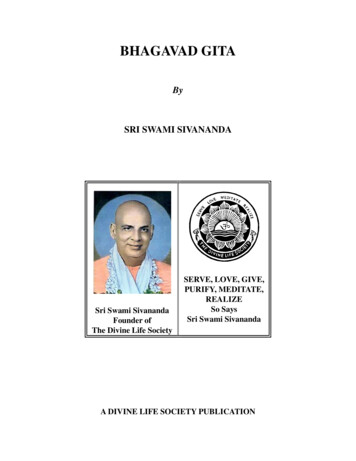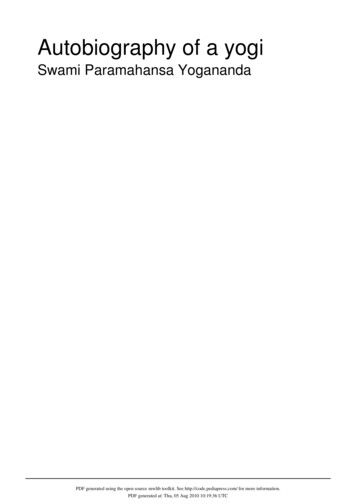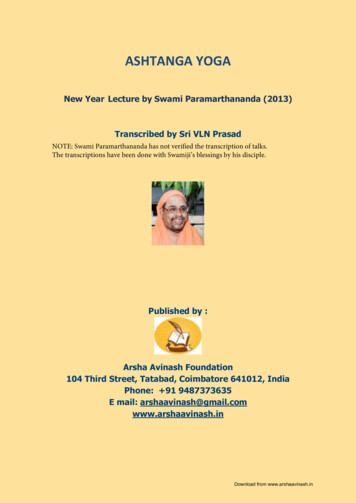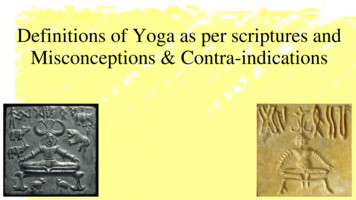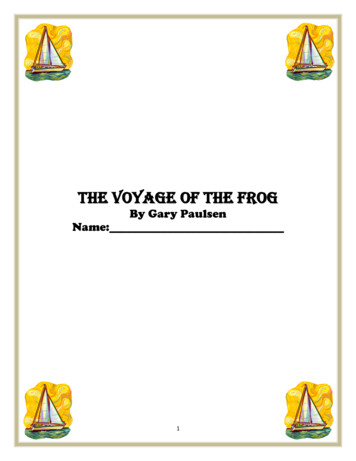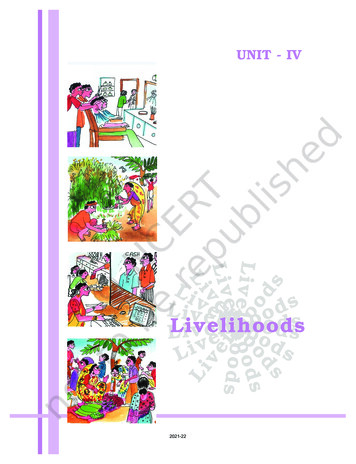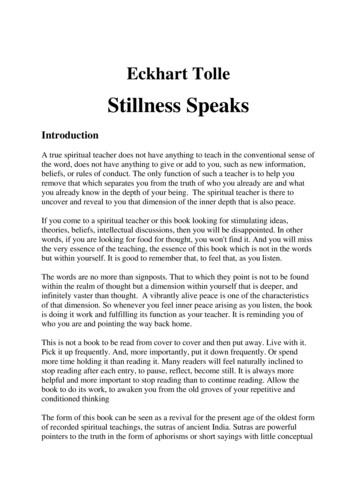
Transcription
WHAT DOES SWAMI SIVANANDATEACH?BySRI N. ANANTHANARAYANANSri Swami SivanandaFounder ofThe Divine Life Society6(59( /29( *,9( 385,) 0(',7 7( 5( /,6(So SaysSri Swami SivanandaA DIVINE LIFE SOCIETY PUBLICATION
First Edition: 1987Second Edition: 1994(2,000 copies)World Wide Web (WWW) Reprint : 1997WWW site: http://www.rsl.ukans.edu/ pkanagar/divine/This WWW reprint is for free distribution The Divine Life Trust SocietyPublished ByTHE DIVINE LIFE SOCIETYP.O. SHIVANANDANAGAR—249 192Distt. Tehri-Garhwal, Uttar Pradesh,Himalayas, India.ii
PUBLISHERS’ NOTESri N. Ananthanarayanan, a sincere devotee of Gurudev Swami SivanandajiMaharaj, has written this book on the basis of the writings of the Master himself. Thequintessence of the teachings of the great saint has been brought together into a focus bythe learned author. The impulsion to bring out this work seems to be an ardent feeling oflove and devotion in the author’s mind, who decided to dedicate this valued offering atthe feet of the venerable Master on the occasion of the holy Centenary. As the authorhimself mentioned in the prolegomena, the book is intended as a useful and handyintroduction to people who are not adequately acquainted with the life and teachings ofthe Master. As the author says, “Its purpose is to arouse their interest in spiritual life ingeneral and the Divine Life chalked out by Swami Sivananda in particular”.We do not know whether to call the sudden appearance of this interestingpublication as a windfall or a Godsend. Either way we are sure that here is somethingwhich every spiritual seeker will relish and consider endearing.12th August, 1987-THE DIVINE LIFE SOCIETYiii
FOREWORDOm Sri Sadguru Paramatmane Namah!Salutations to holy Master Gurudev Swami Sivananda, the modern world teacherand spiritual awakener of the twentieth century mankind. May his living memory and hissacred spiritual message inspire us to live our life in a noble and divine manner, so thatwe are a source of abundant good and benefit to our fellowman and to all life around us.It gives me joy to write this brief foreword to the book, “What Does SwamiSivananda Teach?”, written with much devotion by the well-known compiler of themagnificent volume “Bliss Divine” and author of “From Man to God-man”, a beautifulbiography of Gurudev Swami Sivanandaji with its many interesting illustrations. Thispresent little book is Sri N. Ananthanarayananji’s votive offering placed at Gurudev’s feeton the auspicious occasion of the holy Master’s Birth Centenary on 8th September, 1987.This is the form of Guru-dakshina which Gurudev would rejoice immensely to receive.As such, the present handy brochure constitutes a most appropriate offering upon thisholy occasion. For this reason, it affords me special happiness to write this foreword.Sri N. Ananthanarayanan, the author, is a direct disciple of Sri GurudevSivanandaji, and as such, a Gurubhai of mine. He is a resident Sadhu of Sivanandashram.He has successfully summed up Sri Gurudev’s message to the humanity of the present eraand his simple but inspiring and instructive teachings to the human society of yesterday,today as well as tomorrow upto the future.Covering this subject under twelve well-conceived topics, this book constitutes acall to the life spiritual and serves as an introduction to Divine Life. I have no doubt thatit will be of invaluable help to numerous sincere souls who are seeking for a deepermeaning and a higher purpose in their life. May this loving gift of the author to the globalhuman family serve to bring a new light into the life of its readers and to give an upwardand Godward direction to their living and striving.May the choicest blessings of Gurudev be upon the author as well as all thereaders. Peace and joy to you all.Sivananda Ashram,2-8-1987Swami Chidanandaiv
AUTHOR’S PREFACEThis small book, written specially for the memorable occasion of SwamiSivananda’s Birth Centenary, is the outcome of an inner urge. It is meant to serve as anintroduction to those who are new to Swami Sivananda and his teachings. Its purpose isto arouse their interest in spiritual life in general and in the Divine Life chalked out bySwami Sivananda in particular.While this handy book is not a substitute for one or more of the inspired volumesof the holy Master, it does contain within its pages enough material to enable the reader tostart living the divine life straightaway.This book, written in an absolutely simple style, is interspersed with quotationsfrom the Master and carries stories and anecdotes to sustain reader interest. With thesefew words, I invite the reader to taste the book and derive pleasure and profit therefrom.May the benign grace of the holy Master Swami Sivananda be upon all readers of thebook.Shivananda Nagar,August 1, 1987.N. Ananthanarayananv
CONTENTSPUBLISHERS’ NOTE .iiiFOREWORD . ivAUTHOR’S PREFACFE. v1. THE HUMAN QUEST . 12. GOD, MAN AND THE UNIVERSE. 43. HEALTH FIRST, GOD NEXT. 74. FUNDAMENTALS OF YOGA SADHANA . 115. FOR WHOM IS DIVINE LIFE ?. 166. GOOD LIFE AND GOD-LIFE . 197. THE ART OF KARMA YOGA. 248. THE BHAKTI MARGA . 289. PRACTICE OF MEDITATION. 3610. ON THE CULTIVATION OF BHAV . 4111. THE EGODECTOMY OPERATION. 4812. TO SUM UP. 52vi
WHAT DOES SWAMI SIVANANDA TEACH?1. THE HUMAN QUESTSwami Sivananda does not preach from a podium. He comes down to the level ofthe common man and asks him what he wants. Bang comes the reply: “Happiness!”Happiness is what everyone is after. From cradle to grave, it is the one ceaseless humanquest. The new-born baby seeks comfort in its mother’s bosom. The dying man seekssolace in a last look at his close relatives crowding round his cot. During their earthlysojourn, different people look for happiness in different places, but their goal is common.Some call it happiness. Others call it peace. Sivananda sees everyone striving forit, each in his own way, but not getting it. Happiness, the most sought-after goal of allhuman endeavours, is also the most elusive. Worldly happiness is like the will-o’-thewisp. Just as one seems to secure it, it eludes one’s grasp. Even when secured, it doesnot last. It is fleeting. It is momentary. Not only that, it is invariably mixed with pain.Lasting happiness thus becomes a never-ending chase.Why is this so? Sivananda says that it is because man searches for happiness inthe wrong place. To illustrate his point, the Master tells a story:“A simpleton was passing through a dark tunnel. A coin he was holding in hishand slipped down on the ground. He came out of the tunnel and started vigorouslysearching for it all over the place just outside the tunnel. People got curious. Theyquestioned him. He said, ‘I have lost my money. I am not able to find it, though I havebeen searching for it all day’. ‘Where did you lose it?’ asked a bystander. ‘Inside thattunnel’ came a reply. ‘And why are you searching for it here?’ asked the amazed friend.‘Because it is dark inside the tunnel and bright here!’”“Who will not laugh at such foolishness?” asks Sivananda, “And yet, such truly isthe case with numberless men and women today. They all want peace. They realise thatthey have lost it. They are frantically searching for it. But where? Where they are able tosee. Not where it is, where they lost it!”Peace lies in God. Happiness lies in God, from whom man has descended. Whenman separated from God, he lost his happiness. He can regain that happiness only whenhe returns to God. “Happiness comes when the individual merges in God,” says holyMaster Sivananda in his last sentence, dictated just three weeks before his Mahasamadhi.Once man is merged in God, there is no coming back to this world of woes.Scriptures call it Ananda. Ananda is bliss of the Spirit. It is unmixed with pain.It is also eternal. What man really seeks and fails to obtain on this earth plane is thisAnanda only. This Ananda, this bliss can be had only in God who is all-bliss.Instead of searching for this bliss in God, man looks around for it in the worldoutside. And it is the wrong place in which to look for perpetual bliss. Because, the1
WHAT DOES SWAMI SIVANANDA TEACH?world is certainly not meant to be a place for enjoyment. It is meant to be a place forgaining experience. It is a place for action and evolution.All the scriptures portray the world as an abode of misery. Krishna calls it“ephemeral, unhappy”. Sivananda sees it as a ball of fire. To him the whole worldappears as a huge furnace wherein all living creatures are being roasted. This is not amatter for argument. This is a fact of experience. We see every day people all aroundsuffering in a million ways. There is physical pain. There is mental anguish. There isemotional turmoil. No one is truly happy.The poor man thinks of the rich man, with his wealth, bungalows and cars ishappy. The millionaire thinks that the poor man is happy, since he has nothing in theworld to worry about, no iron-safe to guard, no wealth to insure. But, in truth, real peaceeludes both. It is neither in affluence nor in poverty. True happiness is hidden in Him.What goes by the name of happiness in this world is a sensory feeling. Sivanandacharacterizes it as nervous titillation. “Worldly pleasures are like scratching for itching,”he says. And quite often, what man calls happiness is nothing but the removal of want, ofmisery. Man suffers from hunger. He eats and feels satisfied for the moment. It is butthe removal of the misery of hunger. There is no positive happiness there. Man suffersfrom disease. The doctor cures him and there is a sigh of relief, of apparent happiness.But that happiness is nothing positive, nothing gainful. Examples can be multiplied.Sivananda concedes that there is a grain of pleasure in sense objects, but hastensto point out that the pain mixed with it is of the size of a mountain. “Pleasure that ismixed with pain, fear and worry is no pleasure at all,” he says.Unmixed happiness cannot be had in this world, because this is a world ofDwandwas or pairs of opposites. The world we live in is a world of pleasure and pain,heat and cold, smiles and tears, darkness and light, day and night. It is a world of blackman and white man, of capitalist and communist, of rise and fall of civilizations, of warand peace. This two-sidedness is the very nature of the world we live in and there is noescape from it. It is only those who have no proper understanding of the nature of theworld who expect pure joy from earthly objects.Pure joy, pure bliss is to be had only in God. God is Dwandwatita. He is beyondthe pairs of opposites. He is beyond pleasure and pain, gain and loss, good and bad,beauty and ugliness. He is Anandaghana. He is a mass of bliss. It is by attaining Him,and by attaining Him alone, that man can get everlasting bliss. He cannot get it in thisworld.One may ask, “If happiness cannot be gained in this world, can we not performthe prescribed rituals and go to heaven and enjoy the rhythmic dance of Rambha and themelodious music of Menaka?”. Yes, it is possible. Celestial enjoyment is superior toearthly enjoyment. It is so much more subtle. But there is one difficulty. Enjoyment in2
WHAT DOES SWAMI SIVANANDA TEACH?heaven cannot go on for ever. Heaven is only a Bhoga Bhumi. So is hell. Heaven andhell are just planes of enjoyment. They are planes where man is rewarded or punished forhis actions done on earth. For Punya or merit, man is rewarded in heaven. For Papa orsin, he is punished in hell. Once the Punya or Papa is exhausted by enjoyment orsuffering in heaven or hell, the Jiva is automatically returned to the earth. There is nosuch thing as eternal enjoyment in heaven or eternal damnation in hell. So, going toheaven is no permanent solution to man’s problem of finding lasting happiness. Lastinghappiness can be found only in God and God can be reached only from the earth. Earthonly is the Karma Bhumi where man can do Sadhana, where man can do Tapasya thatwill take him to God and eternal bliss. He cannot do Sadhana in heaven. He can onlyenjoy in heaven for meritorious deeds already performed on earth.So, the first thing that Sivananda would want us to remember is the fact thathuman birth is a most precious acquisition. It is a priceless gift of God, because it is onlyas a human being that one can strive for God-realisation. And having been born as ahuman being in this world, one should not lose that rarest of rare chances to work one’sway onward, forward and Godward.This life is precious. Time is precious. Life is nothing but energy spent in time.The time at the disposal of man is limited. Similarly, the energy at his disposal is limited.Waste of time is waste of life. Waste of energy is waste of life. At the same time, neitherenergy nor time is useful in itself. The energetic man who does not work and the weakman who cannot work are both as good as dead. An intelligent man should thereforeconserve and utilize his time and energy in such a manner as would yield him themaximum spiritual benefit. Acute and constant awareness that with every passing breathour life is getting shortened, and thereby the opportunity given to us to realise God isgetting more and more limited, is the key to speedy progress on the spiritual path.Most people do not recognize the value of time till they hear the gates of death.The Master warns us that death exists side by side with birth. A baby is born. A momentpasses; two moments pass; three, four. With each passing moment, the baby ages; its lifeis cut short and it is brought nearer its death. The march towards death begins with birth.Life is a relentless march from birth to death. It is relentless because time does not stop,the clock does not cease to tick. Time consumes life. No one can escape it. The periodof time vouchsafed to us in this life is preordained as a result of our actions in previousbirths. It is impossible for anyone to alter the life span of an individual by so much as asplit second. He who recognizes this fact is a wise man. For, he will so order his life thatnot a moment is wasted and every moment is well spent in Sadhana, is spiritual striving,in a thrust towards God.3
WHAT DOES SWAMI SIVANANDA TEACH?2. GOD, MAN AND THE UNIVERSEAll right, but who is God? God is the very essence of man. He is the core ofman. He is the innermost life-principle in man. The God in man is called Atman by theHindu scriptures. So, anyone who wants lasting happiness should seek it within himself,in the Atman. Anyone who wants bliss should concentrate his mind on the God within,not on the world without.Further questions arise. If bliss can be had only in God, what is this world? Andthen, if the core of man is God, what is man? What differentiates man and the worldfrom God? The answer, says Sivananda, is simple. God only is. And man is God indisguise. This world is God in disguise. This world is only an appearance. Man is onlyan appearance. The whole creation is an appearance only, an appearance of God.Whereas, God is the reality. He is the only reality. He is the only truth. God alone is,everywhere and at all times.But then, man, this world and all that we see in this seemingly limitless universe. do they exist or not? Gaudapada would have us believe that they do not exist at all.That answer may be the ultimate truth from the standpoint of the realised sage. But to thelayman, it can be maddening. Holy Master Sivananda is more considerate. He does notthrust high philosophy on us, all of a sudden. He does not want us to leap a jump beyondour capacity and break our legs. Rather, he would like us to climb the spiritual ladderstep by step, stage by stage. Sivananda does not believe in spiritual revolution; headvocates spiritual evolution. So he says that this world is real to you as long as you liveand move in it, as long as your feet are firmly planted on it. As long as your hunger hasto be appeased and your thirst quenched, this world is very much real to you and youcannot afford to ignore it. If you ignore it, you will do so at your own peril.Having said so much, the Master goes a step further and throws more light on thesubject. He says that this world is not non-existent like the horns of a hare or the child ofa barren woman. It is there for you to see, hear, smell, taste and touch. Something isthere. But then, when you merge in God, when your mind ceases to be, when yourindividuality is lost, when you transcend world consciousness, when you reach theSamadhi state, then, for you, the world vanishes. Then, in that state, your eyes may beopen, your ears may be open, you may be like any other person to all externalappearances, but the world, including your body and your mind, no longer exists for you.You are gone and only the God in you remains. When you yourself are not there, howcan there be the world? The world also is gone so far as you are concerned.Sivananda gives an example. To the person who dreams in his bed, the lakes andthe castles, the men and the women, and all the objects he sees in his dream are verymuch real as long as the dream lasts. If a small boy sees a tiger in his dream, he shiversand sweats. The tiger is very much real to him. You lose your purse in dream and feelmiserable. You wake up and suddenly feel comforted that it was, after all, a dream. So,4
WHAT DOES SWAMI SIVANANDA TEACH?when you wake up, you know, you realise, that it was after all only a non-existent myth.But, while you were in the state of dream, it all appeared undoubtedly real and true. Theunreality of the dream world is exposed only on waking up. Likewise, says the Master,the unreality of the waking world is known only when you wake up from your spiritualslumber and enter the superconscious state of Samadhi.In this way, the reality of the world depends upon the level of man’sconsciousness. The world is thus not an absolute reality, but a relative reality. The realityof the world is relative to the level of consciousness of the experiencer.To the man in dream, the world is not real. To the man in deep sleep, the world isnot real. To the man who is experiencing superconsciousness, the world is not real. Theworld is real only to the man who is in the waking state of world consciousness.The next logical question is: what is it that determines the level of man’sconsciousness? It is the mind in its various states or the absence of the mind altogether.When the mind in man shines, the God in him is shrouded and not seen. When the mindin man dies, the God in him shines. Thus, it is the mind that separates man from God.God plus mind is man. Man minus mind is God. That is the spiritual equation.One fine morning, Swami Sivananda was seated in his office, surrounded bydevotees. There was a sharp noise and everyone turned around. A disciple who wasserving coffee to the assembled gathering had dropped a porcelain cup and it had brokeninto bits. Exclaimed Sivananda, with a broad smile on his face: “in the beginning therewas One. And the One became many!” The devotees enjoyed the wisdom in Swamiji’shumour.The Vedas declare that God alone was there in the beginning. And that Godwilled: “I am alone. May I become many”. And all this world of multitude came intobeing, like a single flame bursting into a thousand and one sparks or the ocean spillinginto myriad waves, spray, foam and droplets.One may ask: “How is it possible for one God to become many?” It is possiblebecause of His inherent power of Maya. What is inherent power? To cite one or twoexamples. Fire has the inherent power to burn. Ice has the inherent power to cool. Wecannot separate fire from heat or ice from coolness. Even so, we cannot separate Godfrom His power of Maya. And what is Maya? Maya is that inscrutable power that makesnon-existent things appear existent. It is that power which turns one God into myriadmen and mice, angels and devils, planets and pebbles. God only is. Men and mice arenot. Planets and pebbles are not. But they seem to be. How? By Maya’s power. In thisway, God, by His power or Shakti called Maya, acts the drama of this world for His ownsport or Lila, as the scriptures put it.5
WHAT DOES SWAMI SIVANANDA TEACH?There is nothing apart from fire. The flame is fire. The sparks are fire too. Thereis nothing apart from water. The ocean is water. The foam is water. The surf, the wavesand the droplets are water too. Everything is water and water only.Similarly, there is nothing apart from God. All that there is is God only. God,man and the universe are not three different categories. They belong to one and the samecategory. It is all pure consciousness only. Sivananda says that the world is the dazzlingof Brahman-consciousness. But it appears different and manifold when seen through themind. Seen through the eye of intuition, the same world vanishes, leaving behind an allfull God-consciousness.Pure consciousness, pure awareness, God, Brahman,Atman the layman should not get puzzled or confused by all these terms, by all thisjargon. It is all the same. Jargon is inevitable when efforts are made to describe theindescribable, to define the indefinable.God is beyond definition, beyond description. God defined is God denied. Theonly definition of God is that He is beyond definition. Says the Master: “There is nopaper on which to write the nature of Truth. There is no pen which can dare to write It.There is no person living who can express It. It merely is everything that is and thereends the matter. Every effort to express Its nature is trying to kill Its greatness”.Mind is the instrument we use to understand this world, to move about in thisworld, to function in this world, to live our worldly life. But, God is beyond the reach ofthe mind. He cannot be understood by the mind. The mind is incapable ofcomprehending God. The mind is an instrument fashioned by God’s illusory PowerMaya to delude the individual soul into believing that He is mere man and not God.Now, the human mind has its limitations. It is an instrument, which can functiononly within the limits or confines or framework of time, space and causation. Anything,to be comprehended by the mind, should fall within these three categories. All creation iswithin these three categories. But, God is beyond these three categories of time, spaceand causation. God is timeless. He is eternal. He is beyond past, present and future. Heis eternity itself. Similarly, He is beyond space. He is everywhere. He is like a circlewith its centre everywhere and circumference nowhere. God is infinity itself. Lastly,God is beyond causation. No one caused God to come into being. He is being itself. Heis self-existent. He is Svayambhu.The mind, an instrument that is designed to function within the time-spacecausation nexus, cannot comprehend God who is beyond that nexus. To comprehendGod, one must use an instrument that can go beyond time, space and causation. Thatinstrument is intuition.Intuition is gained by transcending the mind. By Sadhana or spiritual effort, themind must be gradually purified or thinned out and made more and more subtle. In thefinal stage, the thinned-out mind must be obliterated. When that is done, intuition dawnsand man slips into the realm of transcendental God-consciousness.We say6
WHAT DOES SWAMI SIVANANDA TEACH?‘transcendental’, because then the mind is transcended, the world consciousness istranscended. In the same way as man wakes up from the world of dream consciousnessinto the world of waking consciousness, in Samadhi, man wakes up from the illusion ofworld consciousness into the reality of God-consciousness.3. HEALTH FIRST, GOD NEXTIf God-realisation is the only option open to man to gain unalloyed bliss, whereexactly does he start his spiritual pilgrimage?Certain basic factors have to be taken care of by the Sadhak or spiritual seeker.The foremost of these is health. “God first, the world next, if at all you want the world”says Swami Sivananda in one of his messages. It may be said with equal validity,“Health first, God next, if at all you want God”. Fundamental to all spiritual Sadhana ishealth. Without health no Sadhana is possible and without Sadhana there can be noSiddhi.“Strengthen the body,” says Sivananda, “and then do spiritual Sadhana”. He goeson to add, “Bodily mortification alone cannot lead to enlightenment without the calmingof the passions and discipline of the mind. Just as striking at an anthill will not destroythe snake within, so also, no amount of bodily torture can kill the mind within.”It is wrong to say that religion prescribes bodily torture. Religion does no suchthing. On the contrary Sri Krishna tells Arjuna, “Do not torture the body and Me whoreside therein.” Sivananda describes the human body as the moving temple of God and asthe chariot of the Soul. It should be kept clean, internally by Brahmacharya andexternally by daily bath. The body is the instrument for Sadhana and it should bemaintained in excellent condition always. The Master likens the body to a horse that willtake the spiritual seeker to the goal. The horse must be given its food and kept strong andhealthy.How to do this? Swamiji remarks good-humouredly, “Dr. Diet, Dr. Quiet and Dr.Cheer.” He emphasizes that health is not just absence of disease, but a positive statebrimming with joy and vitality. He advises the seeker to tone up his health to peak formby taking recourse to Yogasanas, Pranayama, light Sattvic food, moderate sleep, moderateexercise, occasional fasting and a cheerful temperament.Yogasanas and Pranayama bestow bodily vigour, mental alertness and spiritualtranquillity. By preventing the early ossification of bones and by keeping the spine elasticand supple, Yogasanas delay the setting in of old age. Asanas and Pranayama destroylethargy and promote an agile body and an alert mind. They make the breath flowharmoniously. Harmonious flow of breath is the basis of sound health and a sureinsurance against all disease. Asanas and Pranayama are also spiritually beneficial.7
WHAT DOES SWAMI SIVANANDA TEACH?Asanas may be supplemented by some all-round exercise such as walking orswimming; but Swamiji points out and with good reason too, that no amount of exercisecan ever be a substitute for Asanas. This is because Yogasanas vitalize and tone up theall-too-important ductless glands within the body, while physical exercises nourish onlythe superficial muscles.It is important, therefore, that Asanas and exercises are not combined. Thepractice of both in quick succession would mean that neither the vital glands nor the outermuscles would be nourished for a sufficiently long time with fresh blood. Therefore, ifone is done in the morning, the other should be done in the evening. Morning is the idealtime for Yogasanas, which are best practiced on an empty stomach after clearing thebowel.Ladies can benefit from Yogasanas as much as men, but in their case certainrestrictions are to be observed during monthly periods and at the time of pregnancy. Asfor the sick and the weak, while some of the Asanas and Pranayama exercises may not bepossible or even desirable in their case, others could be helpful. Asanas and Pranayamaare wholly prohibited only for children below twelve.The advanced Yogic postures and breathing techniques should be learnt onlyunder the personal guidance of an adept, but the commoner varieties can be practicedeven with the aid of a good book. A useful round of a few Yoga poses and breathingexercises would take just about fifteen minutes, which even a busy man or woman shouldbe able to spare without much difficulty.Each Asana has its own benefits. Sarvangasana, for instance, tones up the thyroidand helps to maintain youthfulness. Sirshasana increases blood supply to the pineal glandand develops brain power. Vajrasana removes drowsiness, strengthens the spine andhelps digestion. Each pose has its own excellence. So is the case with the Pranayamaexercises. Bhastrika generates heat in the body and helps digestion. Sitali cools thesystem and purifies the blood. Kapalabhati tones up the digestive system and improvesappetite.Diseases that defy medical treatment can be cured by suitable Yogic exercisescombined with dietary control. Asanas are a powerful antidote to the wetdreams andspermatorrhoea of boys, the uterine and ovarian disorders of women, and the rheumatism,lumbago and other diseases of the aged. Asanas and Pranayama offer the cheapest andmost natural form of preventive and curative medicine. They are learnt easily. Noextended training is required. No elaborate apparatus need be bought. No gymnasiumneed be built. All that is required is a woolen blanket. The blanket conserves within thebody the current of energy
The poor man thinks of the rich man, with his wealth, bungalows and cars is happy. The millionaire thinks that the poor man is happy, since he has nothing in the world to worry about, no iron-safe to guard, no wealth to insure. But, in truth, real peace eludes both. It is neither in a
